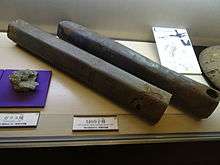M69 incendiary

The M69 incendiary bomblet was used in air raids on Japan and China during World War II. They were nicknamed "Tokyo calling cards".[1] The M69 was a plain steel pipe with a hexagonal cross section 3 inches (7.6 cm) in diameter and 20 inches (51 cm) long. It weighed about 6 pounds (2.7 kg).[2]
The bomblet used napalm (jelled gasoline) as an incendiary filler, improving on earlier designs which used thermite or magnesium fillers that burned more intensely, but were less energy- and weight-efficient, and were easier to extinguish.[3] In Germany they were filled with jellied oil and dropped in clusters of 36 in the non-aerodynamic M19 bomb.[4] Over Japan they were used in clusters of 38 as part of the finned E-46 'aimable cluster', which opened up at about 2,000 ft (610 m). After separation, each of the 38 M69s would release a 3-foot (1 m) cotton streamer to orient its fuze downward.[5][6] Upon hitting a building or the ground, the timing fuze burned for three to five seconds and then a white phosphorus charge ignited and propelled the incendiary filling up to 100 feet (30 m) in several flaming globs, instantly starting intense fires.[2]
It was tested against typical German and Japanese residential structures at Japanese Village and German Village, constructed at Dugway Proving Ground, Utah, in 1943.[7] The M69 was the most successful incendiary in the tests.[2]
Against Japan, the M69 was carried in the bomb bay of the Boeing B-29 Superfortress, with a typical load containing 40 cluster bombs, a total of 1520 M69 bomblets.[2] The bombs were very effective in setting fire to Japanese civilians in mass firebombing raids starting in February 1945 against Kobe.[8] In the first ten days of March 1945, raids with the M69 and M47,[9] extensive damage was done to Tokyo, Nagoya, Osaka, and Kobe.[10]
See also
References
- ↑ 180 Degrees Out: The Change in U.S. Strategic Bombing Applications, 1935-1955- Dissertation of John M. Curatola, DPhil University of Kansas (2008). Quoting "Tokyo Calling Cards", Collier’s Magazine, April 1945, 44 and 58.
- 1 2 3 4 Ross, Stewart Halsey (2002). Strategic Bombing by the United States in World War II: The Myths and the Facts. McFarland. pp. 107–108. ISBN 9780786414123.
- ↑ Science: Incendiary Jelly, Time, Apr. 02, 1945
- ↑ Sion, Edward M. (2008). Through Blue Skies to Hell: America's Bloody 100th in the Air War Over Germany. Casemate Publishers. p. 20. ISBN 9781935149965.
- ↑ Bradley, F.J. (1999). No Strategic Targets Left. Turner Publishing. p. 33. ISBN 9781563114830.
- ↑ "Archived copy". Archived from the original on 2011-06-14. Retrieved 2011-06-14.
- ↑ "Archived copy". Archived from the original on 2010-05-09. Retrieved 2011-06-14.
- ↑ World Battlefronts: BATTLE OF THE PACIFIC: Firebirds' Flight, Time, Mar. 19, 1945
- ↑ http://www.ibiblio.org/hyperwar/AAF/V/AAF-V-20.html
- ↑ World Battlefronts: Ten-Day Wonder, Time, Mar. 26, 1945